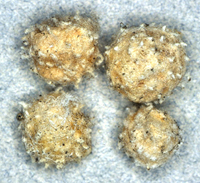Chances are, you have seen a brown widow spider a few times a week, or maybe a day, or (shudder), maybe every hour. These invasive pests, originally from southern Africa, were first observed here in SoCal about eight years ago — and they can not only creep you out, but make life painful.
University of California Riverside arachnologist Rick Vetter asks residents to help him learn more about the 8-legged pest; he wants folks in the Southland to mail him deceased spiders and spider’s spiky egg sacs – if you’re willing to pick either up, that is.
Brown widows prefer to set up home around vegetation, so humans are more likely to see – and yes, get bitten – by the bug when they are outside in the gardens and backyards. The brown widow’s bite is less harmful that their cousin’s the black widow, but it still can hurt like a banshee.
Brown widows can be curled up in leafs, found in solar powered-lights, rims of potted plants, inside children’s toys…pretty much anywhere outside.
Quickly displacing black widows in the area, brown widows are recognizable with their signature hourglass, but instead of red, they feature orange or yellow markings.
…[Vetter] asks that people sending in specimens not spray them with pesticides.
The round, yellow egg sacs of brown widows are distinctive, with spikes that look like a magnified pollen grain. Black widow egg sacs are smooth.
The age of the egg sacs doesn’t matter, and it’s OK if they’re empty, Vetter said. Eggs and spiders should be sent in separate containers, labeled with the city where they were found. He needs about 2,000 egg sacs.
Samples should be sent to Rick Vetter, Brown Widow Project, Department of Entomology, UC Riverside, Riverside, CA 92521.


